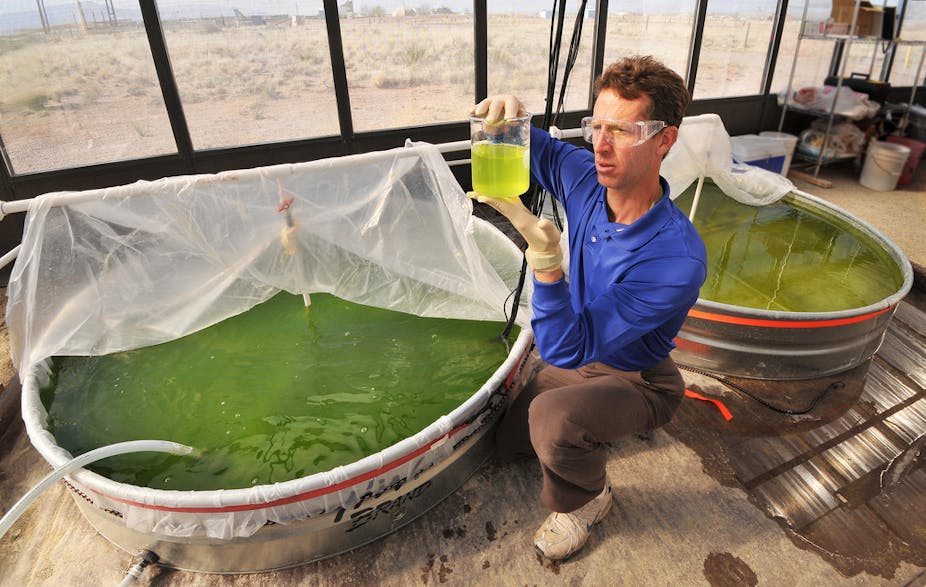It’s one of the key challenges of our generation: transforming our global energy use from emissions-intensive, non-renewable fossil fuels to low-carbon, sustainable energy technologies.
The challenge for the transportation sector is particularly acute. Technology options are limited, consumers are diverse and there are stringent quality requirements (think about jet fuels).
While global demand for transportation fuels continues to grow, easily-extractable crude oil reserves are being depleted and much of the new crude oil production capacity in the next decade will come from higher-cost deep water wells and oil sands.
Biofuels, unlike fossil-based fuels such as unleaded petrol and diesel, are manufactured from renewable biological materials (also called feedstocks).
The public discussion on biofuels in recent years has centred on the narrow food-vs-fuel debate. The reality is that we require a sustainable supply of both food and energy to maintain our quality of life and provide improved opportunities for people in the developing world.
‘First-generation’ biofuels
First-generation biofuels are produced from mostly plant-based starch, sugars and oils. The sugar produced from crops such as sugarcane and sweet sorghum and from starch-based grains such as maize and sorghum can be readily fermented into ethanol.
(Ethanol – the active ingredient in your favourite alcoholic beverages – is often used as motor fuel, including in V8 supercars.)
The oil extracted from oil-seed crops – including canola, soy, Pongamia and Jatropha – and from animal-based tallow, can be converted into a fuel called “biodiesel”.
Unfortunately, starch, sugar and oil crops are also used for human consumption and livestock feed and, as a result, there can be competition for feedstocks, particularly in times of short supply.
This can affect the price and supply of staple food ingredients. And significant increases in feedstock price can make biofuel production uneconomic relative to existing fossil-based fuels.
‘Second-generation’ biofuels
In contrast, second-generation biofuels use lower-value biomass residues – biological material from living or recently living organisms. Such residues can come from forestry, agriculture, municipal solid wastes or dedicated energy crops.
Biomass can be turned into biofuels through a number of advanced processes, including:
biochemical processes which produce fermentable sugars from cellulose (the major constituent of paper)
thermochemical processes such as pyrolysis (in which organic material is decomposed at high temperatures without oxygen)
algal oil production.
There is a huge range of technologies being developed to produce second-generation biofuels.
Fermentable sugars from biomass: Biomass is very resistant to breaking down. The plant has to be pretreated to break open its fibre structure and access the large amount of sugars in its cell wall. Then enzymes are used to convert cellulose into glucose (sugar).
Ethanol and a variety of higher-value chemicals can be produced from the fermentable sugars.
Thermochemical processes: Under high temperatures and pressures, biomass can produce an energy-rich gas, a solid char or a liquid bio-crude. Each of these products can be used as an energy source, or upgraded into other fuels and chemicals.
Algae oils: Algae use sunlight and carbon dioxide to produce oils. Algal oil can be harvested from large-scale open ponds or closed algal photobioreactors.
This oil can then be used in the production of fuels and chemicals or as a nutritional supplement.
Sugars to oils: Conventional yeasts convert fermentable sugars such as glucose into ethanol. But several organisms, including some algae and yeasts, can convert sugars into oils.
These oils can then be used as fuel.
Jet fuel production: Aircraft have particular requirements for fuel quality standards and limited alternative fuel options.
Many of the world’s leading airlines and aviation companies are working together through the Sustainable Aviation Fuels Users Group (SAFUG) to accelerate the development and commercialisation of sustainable aviation fuels, including biofuels.
Members of SAFUG include Boeing, Qantas, Virgin Australia and Air New Zealand.
Sustainability
Much has been said about sustainability when it comes to fossil fuels. But how do second-generation biofuels stack up?
The variation in feedstocks and production processes means all biofuels have different levels of sustainability.
Figuring out the sustainability of biofuels is complex. You have to account for:
the environmental impacts of growing the initial crop
embodied energy: did you get more energy out than you put into growing the crop and the production process?
the greenhouse gas reduction benefits of the fuel.
Whole-of-system impacts are captured in a life-cycle assessment. Biofuels policy makers have to develop robust methodologies so they can understand how indirect land use change affects sustainable biofuels productions.
A number of global organisations, such as the International Standards Organisation and the Roundtable on Sustainable Biofuels, are currently developing sustainability assessment criteria for biofuels.
Second-generation biofuels in Australia
With significant biomass feedstocks – especially in the sugarcane and forestry industries – Australia is well placed to be a leader in commercialising second-generation biofuels.
Companies including car manufacturers, trucking operators, airlines, mining groups, fuel distributors, and consumers, are coming out in support of biofuels.
But the challenge of transforming our transport energy use is complex. It requires a significant long-term commitment to policy measures that support industry development.
With the right policy measures, the uptake of second-generation biofuels in Australia could be rapid – only constrained by our capacity to build new production facilities and supply.

